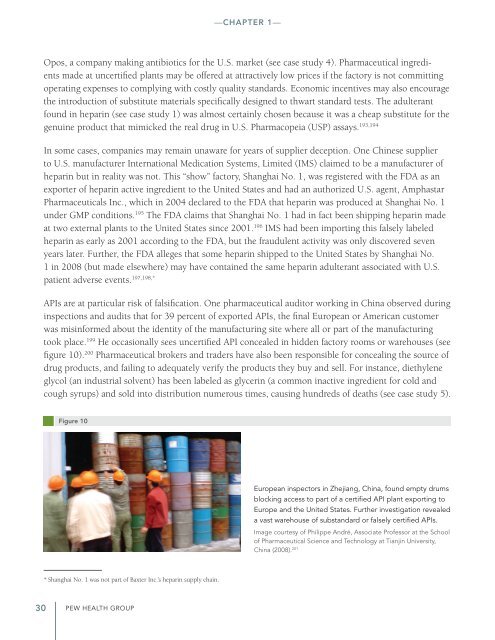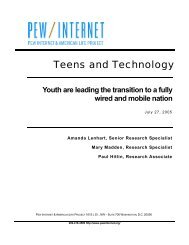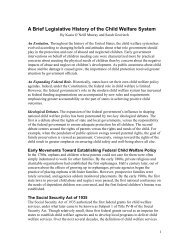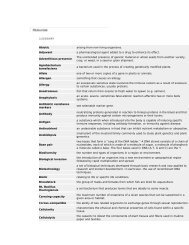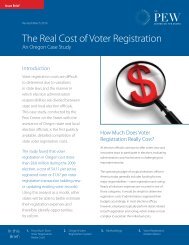After Heparin: - The Pew Charitable Trusts
After Heparin: - The Pew Charitable Trusts
After Heparin: - The Pew Charitable Trusts
Create successful ePaper yourself
Turn your PDF publications into a flip-book with our unique Google optimized e-Paper software.
—Chapter 1—<br />
Opos, a company making antibiotics for the U.S. market (see case study 4). Pharmaceutical ingredients<br />
made at uncertified plants may be offered at attractively low prices if the factory is not committing<br />
operating expenses to complying with costly quality standards. Economic incentives may also encourage<br />
the introduction of substitute materials specifically designed to thwart standard tests. <strong>The</strong> adulterant<br />
found in heparin (see case study 1) was almost certainly chosen because it was a cheap substitute for the<br />
genuine product that mimicked the real drug in U.S. Pharmacopeia (USP) assays. 193,194<br />
In some cases, companies may remain unaware for years of supplier deception. One Chinese supplier<br />
to U.S. manufacturer International Medication Systems, Limited (IMS) claimed to be a manufacturer of<br />
heparin but in reality was not. This “show” factory, Shanghai No. 1, was registered with the FDA as an<br />
exporter of heparin active ingredient to the United States and had an authorized U.S. agent, Amphastar<br />
Pharmaceuticals Inc., which in 2004 declared to the FDA that heparin was produced at Shanghai No. 1<br />
under GMP conditions. 195 <strong>The</strong> FDA claims that Shanghai No. 1 had in fact been shipping heparin made<br />
at two external plants to the United States since 2001. 196 IMS had been importing this falsely labeled<br />
heparin as early as 2001 according to the FDA, but the fraudulent activity was only discovered seven<br />
years later. Further, the FDA alleges that some heparin shipped to the United States by Shanghai No.<br />
1 in 2008 (but made elsewhere) may have contained the same heparin adulterant associated with U.S.<br />
patient adverse events. 197,198,*<br />
APIs are at particular risk of falsification. One pharmaceutical auditor working in China observed during<br />
inspections and audits that for 39 percent of exported APIs, the final European or American customer<br />
was misinformed about the identity of the manufacturing site where all or part of the manufacturing<br />
took place. 199 He occasionally sees uncertified API concealed in hidden factory rooms or warehouses (see<br />
figure 10). 200 Pharmaceutical brokers and traders have also been responsible for concealing the source of<br />
drug products, and failing to adequately verify the products they buy and sell. For instance, diethylene<br />
glycol (an industrial solvent) has been labeled as glycerin (a common inactive ingredient for cold and<br />
cough syrups) and sold into distribution numerous times, causing hundreds of deaths (see case study 5).<br />
Figure 10<br />
European inspectors in Zhejiang, China, found empty drums<br />
blocking access to part of a certified API plant exporting to<br />
Europe and the United States. Further investigation revealed<br />
a vast warehouse of substandard or falsely certified APIs.<br />
Image courtesy of Philippe André, Associate Professor at the School<br />
of Pharmaceutical Science and Technology at Tianjin University,<br />
China (2008). 201<br />
* Shanghai No. 1 was not part of Baxter Inc.’s heparin supply chain.<br />
30<br />
<strong>Pew</strong> Health Group


